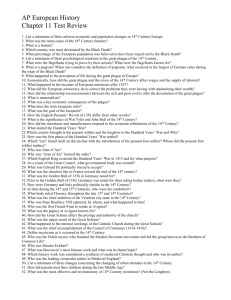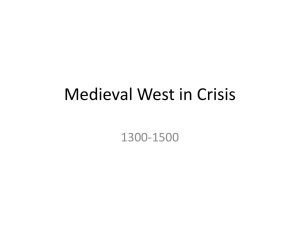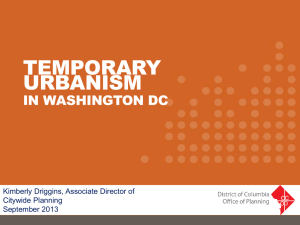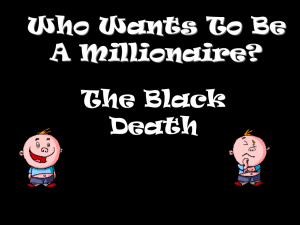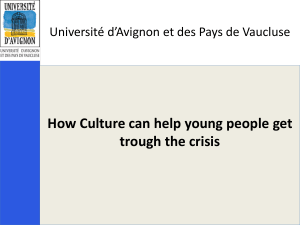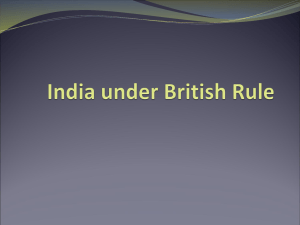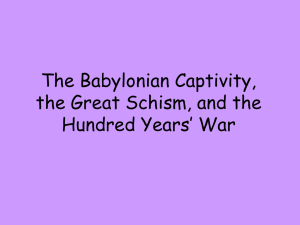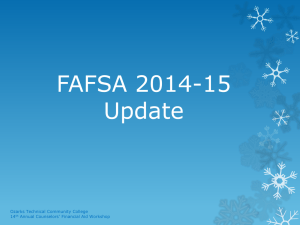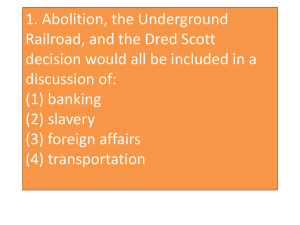The Crisis of the Late Middle Ages (1300
advertisement
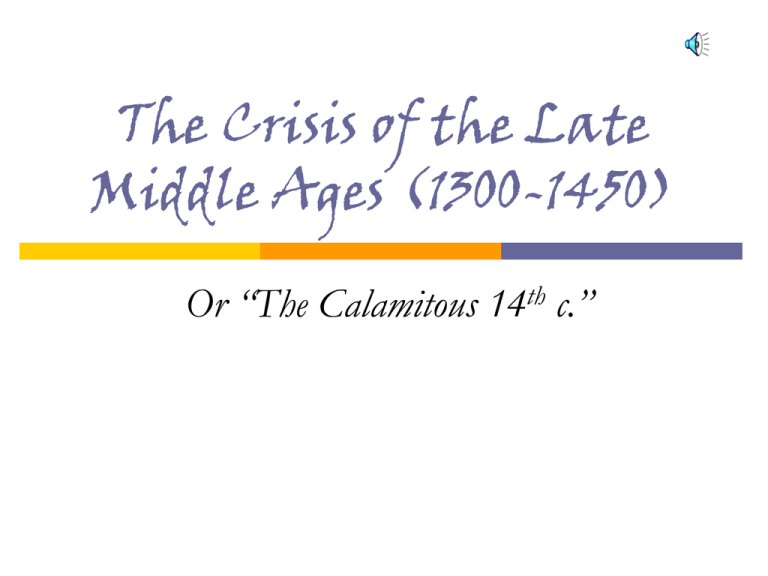
The Crisis of the Late Middle Ages (1300-1450) Or “The Calamitous 14th c.” Introduction Why the “calamitous 14th c.”? From historian Barbara Tuchman’s The Distant Mirror: The Calamitous 14th c. Her thesis: when the gap between the ideal and the real [in society] becomes too wide, the system breaks down. Essential Questions & Objectives Questions: In what ways was the 14th c. “calamitous”? To what extent is Tuchman’s thesis accurate? Objectives: Recognize the geography of Europe in the later Middle Ages. Identify events that have resulted in the use of the term “calamitous” to describe the 14th c. Describe the social characteristics of the 14th c. Geography Europe in 1300 Geography of Europe in 1300 Europe = many small states!! Major states at this time: England Scotland Norway Sweden Portugal Denmark France Bohemia (= Czech Republic today) Austria Teutonic Order (= Baltic states today) Do not yet exist as we know them today: Spain = Castile, Aragon, Granada, Navarre; not united Italy = Sicily, Papal States, + others; not united Germany = not united; part of Holy Roman Empire Netherlands, Belgium, Luxembourg = the Low Countries Russia = group of principalities; Mongol Yoke (1237-1480) Nations of SE Europe = part of Byzantine Empire Europe in 1328 Europe in 1400 Geography of Europe in 1400 From 1300-1400 states consolidated their holdings = fewer small states Major states at this time: England Union of Kalmar = Norway, Sweden, Denmark Scotland Poland-Lithuania Portugal Bohemia France Hungary Austria Wallachia (= Romania today) Ottoman Empire Do not yet exist as we know them today: Spain, Italy, Germay = still not united Russia = still under Mongol Yoke (1237-1480) Events In what ways was the 14th c. “calamitous”? (1) Great Famine (1315-1322) From the Apocalypse in a Biblia Pauperum illuminated at Erfurt around the time of the Great Famine. Death sits astride a lion whose long tail ends in a ball of flame (Hell). Famine points to her hungry mouth. Causes price inflation terrible weather In 1315 the price of wheat rose 800% 3 SFHS cookies cost $1.25. With 800% inflation $10! In 1303 and 1306-1307, the Baltic Sea froze! Dürer’s Four Horsemen of the Apocalypse (1497-98) Consequences susceptibility to disease later marriage population homeless rich farmers buy out poor farmers volatile land market unemployment migration of young males to towns crime War Pestilence Famine Death Int’l trade = consequences spread far Gov’t. responses ineffective (2) Black Death (1348) Boccaccio in The Decameron: The victims ate lunch with their friends and dinner with their ancestors. Causes famine susceptibility to disease advances in shipbuilding Genoese traders carry black rats from the Crimea urban overcrowding & poor sanitation The Culprits The Disease Cycle Flea drinks rat blood that carries the bacteria. Bacteria multiply in flea’s gut. bubonic = spread by flea Human is infected! Flea bites human and regurgitates blood into human wound. pneumonic = spread human-human Flea’s gut clogged with bacteria. The Symptoms Buba Septicemic Form: almost 100% mortality rate. The Mortality Rate 35-70% 25,000,000 dead!!! Consequences – Social pogroms against Jews merchants endow hospitals migration clergy care for sick The burning of Jews in 1349 Consequences – Economic unemployment craft guilds take new members inflation productivity, wages, & standard of living PLabor S1 S P2 P1 D Q2 Q1 Wage Increase QLabor Consequences – Psychological/Cultural pessimism art & lit – theme of death flagellants new colleges & universities – more localized culturally Europe becomes more divided Dance Macabre (Hans Holbein) (3) Hundred Years’ War (ca 1337-1453) ENGLAND VS. FRANCE Battle of Sluys (1340). Illustration from a manuscript of Froissart’s Chronicles. Causes 1: Controversy over succession to French throne Charles IV of France dies heirless French nobility selects Philip VI of Valois Chosen over Edward III of England “no woman or her son could succeed to the [French] monarchy” 1340 – proclaims himself King of France Causes 2: French land belonging to British monarchy English claim Aquitaine as ancient inheritance & occupy it as vassal to French crown Philip VI confiscates Aquitaine in 1337 Aquitaine Pointhieu Causes 3: Struggle for French national identity France disunited French vassals of Philip VI side with Edward III to assert independence from French crown Causes 4: Wool trade & control of Flanders Wool trade b/t England & Flanders Flanders = French fief Flanders wants independence from French rule & asks English for help Flanders Course 1: English Winning at 1st Crécy, Calais, Poitiers, Agincourt English longbow vs. French crossbow Cannon Height of English Dominance, 1429 Course 2: French Victory Joan of Arc to the rescue! Orléans = turning point Consequences Both England • economic problems • development of •social discontent parliament (Commons) • nationalism France • physical destruction • unified France France becomes unified! France in 1453 France in 1337 (4) Church in Decline Babylonian Captivity (1309-1376) Pope in Avignon Popes live extravagantly Rome left in poverty Clement V Avignon Great Schism (1376-1417) 2 popes!! (Rome & Avignon) Gregory XI brings papacy back to Rome Urban VI (Rome) – aggressive reform causes anger & second election Clement VII (Avignon) – “antipope” Great Schism divides Europe politically Conciliarism: Theory Reform movement Pope derives power from entire Christian community Constitutional structure: pope + general council Marsiglio of Padua John Wyclif & Lollards Conciliarism: Practice Council of Pisa (1409) 3 popes!! Council of Constance (1414-1418) – 3 goals: 1. end Great Schism 2. end heresy 3. reform church Jan Hus (5) Fur collar crime Nobles attack rich and poor to raise money (6) Peasant Revolts Jacquerie (1358) Causes: Long-term socioeconomic grievances 100 Years War – taxation English Peasants’ Revolt (1381) Causes: Result: Crushed by nobility Long-term socioeconomic grievances (Statute of Laborers freezes wages) Urging by preachers 100 Years War – French raids Head tax on adult males Result: Crushed by Richard II but serfdom disappeared by 1550 Society Life went on even in the face of calamity. What did 14th c. society look like? Marriage & Family Arranged Based on economics (vs. ♥) Age: men in mid-late 20s, women <20 Children = objects of affection No divorce (annulments in rare cases) Prostitution Legal & regulated Not respected Urban Life in the Parish Work Rural: farming Urban: craft guilds – hard to enter (more open post-plague) Women “inferior” limited opportunities Religion Central to life lay control over parish affairs Recreation Aristocracy: tournaments Commoners: archery, wrestling, alcohol Both: “blood sports,” executions Race & Ethnicity on the Frontiers Migration of peoples to frontier regions “race”/“ethnicity” = used to mean language, customs, laws (vs. blood) Legal dualism: natives subject to local laws & newcomers subject to laws of former homeland Ireland as exception – Statute of Kilkenny (1366) As time passed, moved away from legal dualism toward homogeneity & emphasis on blood descent Dalimil Chronicle Vernacular Literature Dante, Divine Commedy (Italy) Chaucer, Canterbury Tales (England) Villon, Lais & Grand Testament (France) Christine de Pisan, The City of Ladies, etc. (France) lay literacy – due to needs of commerce & gov’t. Dante Christine de Pisan presenting her book to the Queen of France
